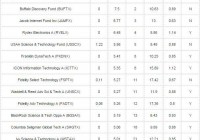A Year-End Review Of ROBO, The Robotics And Automation ETF
Summary The ETF’s percentage of large-cap holdings has declined by 9% since February 2014. Since February 2014, there has been an increase in riskier mid-cap, small-cap and micro-cap holdings within this ETF. Kuka AG and Krones AG are leading performers of the Robo Global Robotics and Automation Index ETF while Omron Corporation and Oceaneering International Inc. are leading laggards. The Robo Global Robotics and Automation Index ETF’s high expense ratio and increased exposure to riskier stocks makes the fund a risky investment. Just like Robin Roberts performs a year-end wrap-up of the year 2015, it is only appropriate that I perform a year-end analysis of the Robo-Stox Global Robotics And Automation Index ETF (NASDAQ: ROBO ) This exchange-traded fund was fortunate enough not to suffer the same fate as the now liquidated 3D Printing, Robotics and Technology Fund (MUTF: TDPIX ). As of the date of this article, the Robo Global Robotics and Automation Index ETF’s total YTD Performance was -4.73%. However, the funds has picked up momentum over the past three months with a gain of 10.54% over that span. Without further ado, it is time for me to perform an in-depth dissection of this fund. The Robo Global Robotics and Automation Index ETF has a high expense ratio of 0.95%. This is 0.30% higher than the expense ratio category average . The following chart illustrates the fund’s weight in terms of giant, large, mid, small and micro-cap stocks when I analyzed this fund in February 2014 . Size % of Portfolio Benchmark Category Average Giant 12.02 56.05 46.73 Large 17.80 21.14 13.74 Medium 40.85 17.44 25.91 Small 13.39 5.24 10.90 Micro 15.94 0.13 2.73 As you can see by the following chart, the percentage of large-cap holdings in the fund has declined by over 9% from nearly two years ago and is well below its category average. Meanwhile, you can see that there has been a percentage increase in the mid-cap, small cap and micro-cap stocks of this fund. These statistics are as of 12/23/2015. Size % of Portfolio Benchmark Category Average Giant 11.22 42.29 3.56 Large 8.79 31.26 28.17 Medium 44.89 19.80 52.11 Small 18.09 6.24 12.66 Micro 17.01 0.41 3.50 LEADERS OF ROBO GLOBAL ROBOTICS AND AUTOMATION INDEX ETF In terms of coming up with the top performers in the fund, I took into account both the portfolio weight and YTD Return of the holdings. KUKA AG ( OTCPK:KUKAF ) = KUKA AG is an automation firm that develops and gives sells robotic systems internationally under the KUKA brand. KUKA AG has the 8th best portfolio weight at 2.14%, yet had an YTD return of 37.10%. Currently, KUKA AG is trading at $87.74 and is coming off of a solid third quarter performance . KUKA AG’s garnered a 25% in orders received and a 34% increase in sales revenues. These increases included totals from the Swisslog division, which was not consolidated in the previous year. The firm’s robotics division increased by 20% in terms of orders received, yet its sales revenues declined by 7% for the quarter. According to its report, KUKA AG have benefited from increased car sales in its three biggest markets, Western Europe, China and the U.S. Car sales in Western Europe, China and The U.S grew by 8.7%, 5.5% and 5% respectively for the first nine months in 2015. KUKA expects to benefit from further growth in these markets. KRONES AG ( OTC:KRNNF ) – Krones AG is responsible for the planning, developing and manufacturing machinery and systems for the process technologies and intralogistics arena in Germany as well as worldwide. Krones AG has a 2.06% portfolio weight and has an YTD return of 34.35%. Krones is trading at $108.25. Its latest report revealed that Krones AG was right on target in terms of meeting its target objectives. Krones AG’s revenue and net orders has increased by 4.9% and 5.2% respectively. The firm’s EBIT, EBT and Net Income increased by 14.8%, 14.2% and 13.9% respectively. LAGGARDS OF ROBO GLOBAL ROBOTICS AND AUTOMATION INDEX ETF It would be easy for me to point the finger at the struggling 3-D Printing stalwarts of 3D Systems Corp (NYSE: DDD ) and Stratasys (NASDAQ: SSYS ). Both have YTD Returns of -69.29% and -69.12%. However, both holdings hold portfolio weights of less than 1%. Thus, both holdings do not hold enough significance to the fund at this point. However, Omron Corporation (OMR) has a hefty portfolio weight of 2.12% and has a negative YTD Return of -22.50%. In their latest half-year report, Omron Corporation’s revenue increased year-over-year by 2.2%. Yet, the company’s net income declined by -27.3% to $24.5 million dollars. Omron’s operating income was dragged down by a mix of increased SG&A and R&D and lower added value. Oceaneering International Inc. (NYSE: OII ) has a sizable portfolio weight of 1.74% and has a YTD return of -33.79%. Oceaneering International Inc. just hit a new one-year low on Dec 21st. This came on the heels of Oceaneering International Inc. being downgraded to a Strong Sell by Zacks. In the company’s latest report, Oceaneering International Inc’s reported a 31% decrease in net revenues and an 81% decline in net income. BOTTOM LINE: I still cannot give this ETF my full endorsement as an investment as it is still overly exposed to riskier stocks as shown by the chart comparisons above. In addition, Morningstar rates this fund zero stars and has an F rating by ETF.com. The fund’s high expense ratio of 0.95% is an even bigger turnoff. Editor’s Note: This article discusses one or more securities that do not trade on a major U.S. exchange. Please be aware of the risks associated with these stocks.
